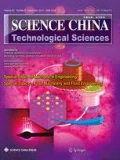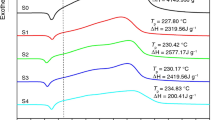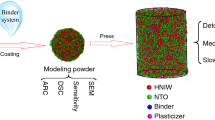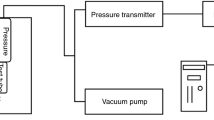Abstract
In this study, the thermal stability and detonation properties of three types of explosives were investigated. Results indicated that nanoaluminum powder improved the detonation properties of HMX by increasing the specific surface area of HMX, which substantially increased the explosion heat and power. The decomposition temperatures of the three explosives containing aluminum hydride, ammonia borane, and nanoaluminum powder during slow cook-off at heating rates of 1.5 and 10°C min–1 were measured as 246°C and 241°C, 256°C and 261°C, and 238°C and 264°C, respectively. The explosives containing hydrogen storage materials swelled; however, the nanoaluminum powder was only slightly peeled off at the edge of the grains during cookoff. Differential scanning calorimetry (DSC) curves of the explosives containing hydrogen storage materials exhibited endothermic and exothermic peaks before the major exothermic reaction peak during the cook-off tests. In contrast, only one weak peak was observed in the DSC curve of the explosive containing nanoaluminum powder before the major exothermic reaction. In addition, the additives and adhesives catalyzed the slow cook-off decomposition, which caused the transformation of HMX crystals and accelerated the thermal decomposition reaction of HMX. The addition of high-density hydrogen storage materials to HMX resulted in detonation heats and explosion powers much greater than cure HMX. This improved performance was attributed to the hydrogen storage materials in the explosives participating in a secondary reaction in the reaction zone at the instant of the explosion, effectively realizing complementary lossless energy and thus greatly improving the explosive power of the explosives.
Similar content being viewed by others
References
Zhang C, Sun C, Hu B, et al. Synthesis and characterization of the pentazolate anion cyclo-N5 - in (N5)6(H3O)3(NH4)4Cl. Science, 2017, 355: 374–376
Wang Z Y. New progress in the study of high-energy density compounds abroad. Aircraft Missile, 2003, 2: 34–37
Lei Y P, Xu S L, Yang S Q, et al. Overview of overseas research institutions and main research results of high-energy materials. Pyrotechnics, 2006, 5: 45–50
Gao H, Shreeve J M. Azole-based energetic salts. Chem Rev, 2011, 111: 7377–7436
Schwarz R B, Brown G W, Thompson D G, et al. The Effect of shear strain on texture in pressed plastic bonded explosives. Propell Explos Pyrotech, 2013, 38: 685–694
Klapötke T M, Witkowski T G, Wilk Z, et al. Determination of theinitiating capability of detonators containing TKX-50, MAD-X1, PETNC, DAAF, RDX, HMX or PETN as a base charge, by underwater explosion test. Propell Explos Pyrotech, 2016, 41: 92–97
Meng L I, Zhao F Q, Yang L, et al. Energetic characteristics computation of propellants containing dihydroxylammonium 5,5'-bistetrazole- 1,1'-diolate (TKX-50). Chin J Energ Mater, 2014, 3: 286–290
Byrd E F C, Scuseria G E, Chabalowski C F. An ab initio study of solid nitromethane, HMX, RDX, and CL20: Successes and failures of DFT. J Phys Chem B, 2004, 108: 13100–13106
Nouri A, Zahedi E, Ehsani M, et al. Understanding the kinetics and molecular mechanism of the Curtius rearrangement of 3-oxocyclobutane- 1-carbonyl azide. Comput Theor Chem, 2018, 1130: 121–129
Bi X L, Liu J P, Ma C. Research on the performance of boron particles with HTPB. J Beijing Inst Technol, 2014, 23: 206–209
Tang C, Yan H, Li M, et al. A novel phosphorus-containing polysiloxane for fabricating high performance electronic material with excellent dielectric and thermal properties. J Mater Sci-Mater Electron, 2018, 29: 195–204
Zhang W, Liu Y F, Xie W X, et al. Study on compatibility of AlH3 with compositions of solid propellant by thermal analysis method. Chin J Explos Propell, 2015, 1: 41–46
Allaria E, Diviacco B, Callegari C, et al. Control of the polarization of a vacuum-ultraviolet, high-gain, free-electron laser. Phys Rev X, 2014, 4: 041040
Dong H S. Development and countermeasures of high energy density materials. Energy Contain Mater, 2004, 12: 1–12
özhava D, özkar S. Nanoalumina-supported rhodium(0) nanoparticles as catalyst in hydrogen generation from the methanolysis of ammonia borane. Mol Catal, 2017, 439: 50–59
Agrawal J P. Some new high energy materials and their formulations for specialized applications. Propell Explos Pyrotech, 2005, 30: 316–328
Zhou L, Xie Z, Wei X. Comparison of underwater shock wave attenuation of a new insensitive high explosive with different explosives. Combust Explos Shock Waves, 2011, 47: 721–726
Koutsospyros A, Christodoulatos C, Panikov N, et al. Environmental relevance of CL-20: Preliminary findings. Water Air Soil Pollut-Focus, 2004, 4: 459–470
Guo Y, Yu X, Sun W, et al. The hydrogen-enriched Al-B-N system as an advanced solid hydrogen-storage candidate. Angew Chem Int Ed, 2011, 50: 1087–1091
Ben-Itzhak I, Wells E, Studanski D, et al. Double and single ionization of hydrogen molecules by fast-proton impact. J Phys B-At Mol Opt Phys, 2001, 34: 1143–1161
Victor A C. Simple calculation methods for munitions cookoff times and temperatures. Propellants Explos Pyrotech, 1995, 20: 252–259
Ramskill P K. A description of the “engulf” computer codes-codes to model the thermal response of an LPG tank either fully or partially engulfed by fire. J Hazard Mater, 1988, 20: 177–196
Aydemir E, Ulas A, Serin N. Thermal decomposition and ignition of PBXN-110 plastic-bonded explosive. Propell Explos Pyrotech, 2012, 37: 308–315
Ma X, Chen L, Lu F, et al. Calculation on multi-step thermal decomposition of HMX-and TATB-based composite explosive under cook-off conditions. Explos Shock Waves, 2014, 1: 67–74
Bazyn T, Eyer R, Krier H, et al. Combustion characteristics of aluminum hydride at elevated pressure and temperature. J Propul Power, 2004, 20: 427–431
DeLuca L T, Galfetti L, Severini F, et al. Physical and ballistic characterization of AlH3-based space propellants. Aerosp Sci Tech, 2007, 11: 18–25
Il’in A P, Bychin N V, Gromov A A. Products of combustion of aluminum hydride in air. Combust Explos Shock Waves, 2001, 37: 490–491
Xu B, Liu J, Zhao L, et al. Theoretical study on the structure and stability of aluminum hydride (AlnH3n) clusters. J Mater Sci, 2013, 48: 2647–2658
Chen D S, Wong D S H, Chen C Y. Neural network correlations of detonation properties of high energy explosives. Propell Explos Pyrotech, 1998, 23: 296–300
Wang C, Dong X Z, Shu C W. Parallel adaptive mesh refinement method based on WENO finite difference scheme for the simulation of multi-dimensional detonation. J Comput Phys, 2015, 298: 161–175
Wang C, Zhang X, Shu C W, et al. Robust high order discontinuous Galerkin schemes for two-dimensional gaseous detonations. J Comput Phys, 2012, 231: 653–665
Author information
Authors and Affiliations
Corresponding author
Rights and permissions
About this article
Cite this article
Liu, J., Yang, W., Liu, Y. et al. Mechanism and characteristics of thermal action of HMX explosive mixture containing high-efficiency fuel. Sci. China Technol. Sci. 62, 578–586 (2019). https://doi.org/10.1007/s11431-018-9464-8
Received:
Accepted:
Published:
Issue Date:
DOI: https://doi.org/10.1007/s11431-018-9464-8




